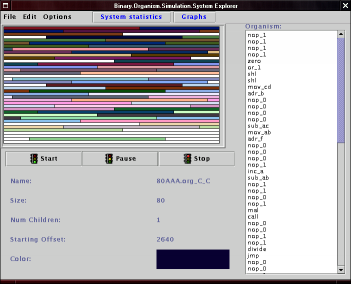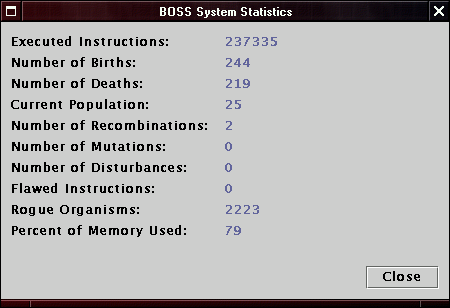- Number of Executor threads: The number of Executor threads
that will be running at any given time. If you have only one
processor, you should keep this at 1 for maximal speeds.
(must be an integer greater than zero)
- Number of Mutator threads: The number of Mutator threads
that will be running at any given time. This will also increase
the chance of a mutation. Each thread at every timestep will have
a chance to cause a mutation. This does not affect mutations at
birth.
(must be an integer equal to, or greater than zero)
- Number of Disturbance threads: The number of Disturbance
threads that will be running at any given time. This will also increase
the chance of a disturbance. Each thread at every timestep will have
a chance to cause a disturbance.
(must be an integer equal to, or greater than zero)
- Memory size: The size of the soup. This should be an
integer that is a multiple of 5. This must be at least 3 times the
size of the organism you plan to load in.
- Allocation allowance: This is how much each organism is
allowed to allocate relative to it's own size. An allocation allowance
of 1.0 means each organism can allocate a maximal amount of space
equal to it's own size. An allocation allowance of 3.0 means an
organism can allocate as much as three times it's original size.
(must be a floating point greater than 0.0)
- Used memory allowance: This is the maximum percent of memory
we are allowed to use at any given time. If the memory soup reaches
this maximal percentage, we do some spring cleaning to kill off
organisms until we reach the desired level. (must be between 0.0
and 1.0)
- Max stack size: This is the maximum stack size of the cpu.
A smaller stack will cause larger organisms to have more errors.
|

|







